Articles
- Page Path
- HOME > Korean J Community Nutr > Volume 21(2); 2016 > Article
-
Research Article
- Study on Energy and Nutrient Intake and Food Preference of the Elderly in Care Facilities
-
Jong-Sook Kwon
 , Seung Hee Lee, Kang Min Lee, Yoonna Lee
, Seung Hee Lee, Kang Min Lee, Yoonna Lee -
Korean Journal of Community Nutrition 2016;21(2):200-217.
DOI: https://doi.org/10.5720/kjcn.2016.21.2.200
Published online: April 30, 2016
1Department of Food and Nutrition, Shingu College, Seongnam, Korea.
2Love and Good Deed, Seongnam, Korea.
- Corresponding author: Jong-Sook Kwon. Department of Food and Nutrition, Shingu College, 377 Gwangmyeong-ro, Jungwon-gu, Seongnam, Gyeonggi-do, 13174, Korea. Tel: (031) 740-1642, Fax: (031) 740-1590, jskwon@shingu.ac.kr
Copyright © 2016 The Korean Society of Community Nutrition
This is an Open-Access article distributed under the terms of the Creative Commons Attribution Non-Commercial License (http://creativecommons.org/licenses/by-nc/3.0/) which permits unrestricted non-commercial use, distribution, and reproduction in any medium, provided the original work is properly cited.
- 1,001 Views
- 4 Download
- 14 Crossref
Abstract
-
Objectives
- The purpose of this study was to assess energy and nutritional intake and investigate the preference for food and cooking methods of the residents in elderly care facilities.
-
Methods
- Data were collected from 72 residents (10 males and 62 females) aged ≥ 70 years in elderly care facilities using questionnaires, food photographs for estimating dietary intake and records for daily physical activity.
-
Results
- Average age of the study participants was 85.0 years and 41, 36 and 8 had dementia, hypertension and diabetes mellitus, respectively. 15%, 65% and 19% of subjects were physically mobile, enervated, and immobile, respectively. Daily energy intake was 1360.2 kcal in men and 1378.0 kcal in women, which were 68.0% and 86.1% of the estimated energy requirement (EER) of dietary reference intake for Koreans (KDRI) for ≥ 75 year old individuals, respectively. Estimated energy expenditure (EEE) of subjects calculated using formula from KDRI was 1361.9 kcal and EER calculated using estimated daily physical activity (EDPA) was 1232.9 kcal. Energy intake and EEE from KDRI were higher than EER from EDPA. Dietary intake of dietary fiber, calcium, potassium, zinc, vitamin B2, niacin, vitamin C were lower, and protein, phosphorous, iron, sodium, vitamin A, vitamin B1, vitamin B6, vitamin E were higher than the corresponding ones of KDRI. Subjects liked meats, fishes and shellfish, and fruits, while subjects disliked milk, seaweeds and salted fish and salted vegetables. Cooked rice, soybean paste soup, beef, cooked sliced radish strip, and yogurt were favorite foods, with steam being a favorite cooking method. Subjects considered nutrition as the most important factor for improving food service quality.
-
Conclusions
- Results of this study could be utilized for improving food-service for the residents in elderly care facilities, and provide a basis for setting reference intake of energy and nutrients of the elderly having very low activity levels.
Acknowledgments
Acknowledgments
- 1. Statistics Korea. Annual report on the Statistics for elderly [internet]. 2014; cited 2014 Jun 19]. Available from: http://kostat.go.kr.
- 2. Shahar D, Shai I, Vardi H, Fraser D. Dietary intake and eating patterns of elderly people in Israel: who is at nutritional risk? Eur J Clin Nutr 2003; 57(1): 18-25.ArticlePubMedPDF
- 3. Kwak KS, Bae YJ, Kim MH. Nutritional status and dietary quality in the low-income elderly residing at home or in health care facilities. J Korean Diet Assoc 2008; 14(4): 337-350.
- 4. Ministry of Health and Welfare, Korea center for disease control and prevention. 2013 Korea national health and nutrition examination survey [internet]. 2014; cited 2014 Dec 22]. Available from: http://knhanes.cdc.go.kr.
- 5. Long Term Care Insurance. Insurance benefit in-home service [internet]. 2010; cited 2010 Aug 22]. Available from: http://www.longtermcare.or.kr.
- 6. Sunwoo D. An improvement plan for the government policy on long-term care insurance. Health Welf Policy Forum 2010; 10(168): 16-24.
- 7. Han HY. A study on the satisfaction degree of elderly care facilities and long-term care service -focused on Seoul, Incheon and Gyeonggi. [master's thesis]. Hanyang University; 2013.
- 8. Ministry of Health and Welfare. Guideline for social welfare service for the elderly [internet]. 2012; cited 2012 Jul 12]. Available from: http://www.mohw.go.kr/front_new/jb/sjb0406vw.jsp?PAR_MENU_ID=03&MENU_ID=030406&BOARD_ID=5900&BOARD_FLAG=04&CONT_SEQ=320690&page=1.
- 9. Kim WY, Ahn SY, Song YS. The nutritional status and intervention effects of multivitamin-mineral supplementation in nursing-home residents in Korea. Korean J Community Nutr 2000; 5(2): 201-207.
- 10. Yoon MO, Moon HK, Jeon JY, Sohn CM. Nutritional management by dietitian at elderly nursing homes in Gyeonggido. J Korean Diet Assoc 2013; 19(4): 400-415.Article
- 11. Japan Ministry of Health, Labour and Welfare. Long-term care, health and welfare services for the elderly [internet]. 2012; cited 2012 Jan 30]. Available from: http://www.mhlw.go.jp.
- 12. National Institute on Aging. Health eating after 50 [internet]. 2012; cited 2012 Jan 30]. Available from: http://www.nia.nih.gov.
- 13. Han HK, Choi SS, Kim MW, Lee SD. Food habits and nutritional status of the long-lived elderly people in Ganghwagun area. Korean J Community Nutr 2005; 10(1): 101-110.
- 14. Yoon HJ, Lee HK, Lee SK. The health status and nutrient intakes of elderly female in Daegu area. Korean J Community Nutr 2007; 12(1): 50-57.
- 15. Lee MS. Nutritional status of the oldest-elderly population in Sunchang county. Korean J Community Nutr 2009; 14(3): 255-265.
- 16. Kwak CS, Cho JH, Yon M, Park SC. Anthropometric index, dietary habits and nutrient intake of the oldest-old population aged 95 and over living in Seoul. Korean J Community Nutr 2012; 17(5): 603-622.Article
- 17. Korea Health Industry Development Institute (KHIDI), Nongshim. In-depth Analsyis on Eating Habits and Health Status of Present and Future Consumer - based on Korea National Health and Nutrition Examination Survey (KNHANES IV and V) data. KHIDI; 2012 Dec. Report No. Private Sector-Nutrition-2012-67.
- 18. Lee KH, Park JR, Seo JS. Nutritional status of the elderly living in a private silver town of Busan metropolitan city, Korea. J Korean Soc Food Sci Nutr 2007; 36(10): 1293-1299.Article
- 19. Kwon JS, Kim K, Kim HK. A study on application of food photographs for estimating individuals dietary intake. Korean J Community Nutr 2010; 15(6): 760-775.
- 20. Korean Nutrition Society. Dietary reference intake for Koreans. 1st revision. Seoul: The Korean Nutrition Society; 2010. p. xxv-xxix. p. 30-32.
- 21. Choi HM. Nutrition. 3rd ed. Paju: Kyomunsa; 2006. p. 176-177. p. 584-586.
- 22. Suh HJ, Lee Y, Jang Y, Kim B, Lee H, Kim CI. Current status and management of congregate meal service program for the elderly at community centers. J Korean Diet Assoc 2004; 10(3): 333-344.
- 23. National health insurance service. Long-term care insurance [internet]. 2016; cited 2016 Feb 1]. Available from: http://www.nhis.or.kr/menu/retriveMenuSet.xx?menuId=B3300.
- 24. Cho KJ, Han DH. Study on food habits of the elderly in institution. J Korean Soc Food Sci Nutr 1998; 27(4): 756-764.
- 25. Roberts SB. Effects of aging on energy requirements and the control of food intake in men. J Gerontol A Biol Sci Med Sci 1995; 50(Spec No): 101-106.PubMed
- 26. Volkert D, Kreuel K, Heseker H, Stehle P. Energy and nutrient intake of young-old, old-old and very-old elderly in Germany. Eur J Clin Nutr 2004; 58(8): 1190-1200.ArticlePubMedPDF
- 27. Bell J, Whiting SJ. Elderly women need dietary protein to maintain bone mass. Nutr Rev 2002; 60(10): 337-341.ArticlePubMed
- 28. Chobanian AV, Hill M. National heart, lung, and blood institute workshop on sodium and blood pressure: A critical review of current scientific evidence. Hypertension 2000; 35(4): 858-863.ArticlePubMed
- 29. Ahn SH, Kim HK, Kim KM, Yoon JS, Kwon JS. Development of nutrition education program for consumers to reduce sodium intake applying the social cognitive theory: based on focus group interviews. Korean J Community Nutr 2014; 19(4): 342-360.Article
- 30. He FJ, Macgregor GA. Reducing population salt intake worldwide: from evidence to implementation. Prog Cardiovasc Dis 2010; 52(5): 363-382.ArticlePubMed
- 31. Park YS, Son SM, Lim WJ, Kim SB, Chung YS. Comparison of dietary behaviors related to sodium intake by gender and age. Korean J Community Nutr 2008; 13(1): 1-12.
- 32. Catholic University of Korea & Management Center for Health promotion. Integrated health promotion service in community health center. 2010. p. 22-48.
- 33. Jimenez-Redondo S, Beltrán de Miguel B, Gavidia Banegas J, Guzmán Mercedes L, Gomez-Pavon J, Cuadrado Vives C. Influence of nutritional status on health-related quality of life of non-institutionalized older people. J Nutr Health Aging 2014; 18(4): 359-364.ArticlePubMedPDF
- 34. Lee HS. The Factors Influencing Health-Related Quality of Life in the Elderly: Focused on the General Characteristics, Health Habits, Mental Health, Chronic Diseases, and Nutrient Intake Status: Data from the Fifth Korea National Health and Nutrition Examination. Korean J Community Nutr 2014; 19(5): 479-489.Article
- 35. Chang YK, Park HR, Byun KW, Kwon JS. Basic nutrition. Seoul: Kyomunsa; 2006. p. 198-288.
- 36. Kim HY, Lee SH, Lim YL. A study on the dietary and nutrition intake of the elderly resident in nursing home. J Korea Goron Soc 1995; 15(2): 69-83.
- 37. Seo S, Yun N. Foodservice management and food safety knowledge and practices of employees in elderly welfare facilities. J Korean Diet Assoc 2011; 17(3): 287-301.
- 38. Hong SY, Seo S. Job performance frequency and the training needs of dieticians in elderly healthcare facilities. J Korean Diet Assoc 2010; 16(2): 160-177.
- 39. Wouters-Wesseling W, Wouters AE, Kleijer CN, Bindels JG, de Groot CP, van Staveren WA. Study of the effects of a liquid nutrition supplement on the nutritional status of psycho-geriatric nursing home patients. Eur J Clin Nutr 2002; 56(3): 245-251.ArticlePubMedPDF
- 40. Nijs KA, de Graaf C, Kok FJ, van Staveren WA. Effect of family style mealtimes on quality of life, physical performance, and body weight of nursing home residents: cluster randomised controlled trial. BMJ 2006; 332(7551): 1180-1184.ArticlePubMedPMC
REFERENCES
Energy and nutrient intakes and estimated energy expenditures of study subjects
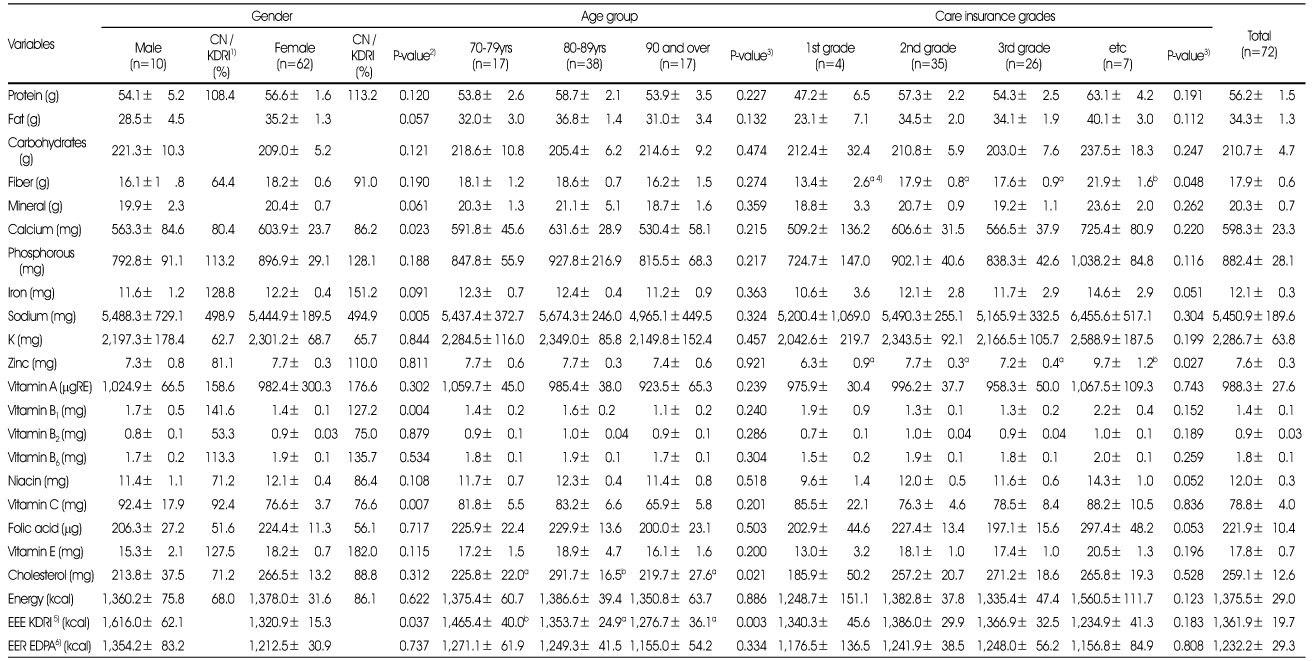
1) Consumed nutrients /Dietary reference intake for Koreans age of 70 and more
2) Student's t test
3) One-way ANOVA
4) Values with different alphabets in each row are significantly different at α=0.05 by Duncan's multiple range test
5) Estimated energy expenditure from Dietary Reference Intake for Koreans
6) Estimated energy requirement from estimated daily physical activity
Figure & Data
REFERENCES
Citations

- Snack Provision Practice in Long-Term Care Hospitals and Facilities in Korea
Dayeong Yeo, Hae Jin Kang, Hyejin Ahn, Yoo Kyoung Park
Clinical Nutrition Research.2024; 13(2): 108. CrossRef - A Comparison of Status of Nutrition Management in Long-Term Care Facilities With and Without Dietitian
Jin Hee Kwon, Rah Il Hwang, Jaehyeon Ryu
Journal of Health Informatics and Statistics.2022; 47(1): 27. CrossRef - Classification of Texture-Modified Korean Soups with a Thickener under IDDSI Criteria
Kui-Jeong Choi, Hyun-Jung Lee, Weon-Sun Shin
Journal of the Korean Dysphagia Society.2022; 12(2): 123. CrossRef - Current status of foodservice nutrition management and effects of welfare facility support for the elderly in Cheongju City
Joo-Eun Lee
Nutrition Research and Practice.2022; 16(4): 527. CrossRef - Comparison of Food Service Provision by Food Service Operational Types for Residential Facilities
Jin Hee Kwon, Rah Il Hwang, Hyeon Jin Jeong, Hye Min Jang
Journal of Health Informatics and Statistics.2022; 47(4): 258. CrossRef - Factors Associated with Person-Centered Care among Care Workers at Long-term Care Facilities
Geun-Young Kim, Hye-Young Jang
Journal of Korean Gerontological Nursing.2021; 23(1): 13. CrossRef - Dietary quality of lunches in senior leisure service facilities in South Korea: analysis of data from the 2013–2017 Korea National Health and Nutrition Examination Survey
Daeun Choi, Youngmi Lee, Haeryun Park, Kyunghee Song, Jinah Hwang
Nutrition Research and Practice.2021; 15(2): 266. CrossRef - Evaluation of the dietary quality and nutritional status of elderly people using the Nutrition Quotient for Elderly (NQ-E) in Seoul
Sun-Wook Ham, Kyung-Hee Kim
Journal of Nutrition and Health.2020; 53(1): 68. CrossRef - Status of health and nutritional intake of the elderly in long-term care facilities: focus on Gwangju Metropolitan City
Gyusang Han, Eunju Yang
Journal of Nutrition and Health.2020; 53(1): 27. CrossRef - Study on the Nutrient Intake and Dietary Quality of Elderly Residents on Various Meal Types in Long-Term Care Facility
Hee-Sook Lim, Eun Bi Oh, Yoo Kyoung Park, Hae-Yun Chung
Journal of the East Asian Society of Dietary Life.2020; 30(2): 172. CrossRef - Health and Nutrition Status of Elderly People with Multimorbidity: A Korea National Health and Nutrition Examination Survey (2013~2015)
Na-Gyeong Oh, Jung-Sook Seo
Korean Journal of Community Nutrition.2020; 25(6): 502. CrossRef - Nutritional status of Korean elderly with dementia in a long-term care facility in Hongseong
Ji-Yeon Lee, Yeong-Soon Hyun, Hee-Seon Kim
Nutrition Research and Practice.2019; 13(1): 32. CrossRef - Food and nutrient intake status of Korean elderly by perceived anxiety and depressive condition: data from Korean National Health and Nutrition Examination Survey 2013 ~ 2015
Da-Mee Kim, Kyung-Hee Kim
Journal of Nutrition and Health.2019; 52(1): 58. CrossRef - Analysis of Food Preference, Recognition and Experience of Elderly Foods among Elderly People
Mi Young Kim, Yoo Na Lee
The Korean Journal of Food And Nutrition.2016; 29(6): 971. CrossRef
General characteristics of the study subjects
1) student's t test
2) One-way ANOVA
3) Values with different alphabets in each row are significantly different at α=0.05 by Duncan's multiple range test
4) N (%)
5) Chi-square test
Energy and nutrient intakes and estimated energy expenditures of study subjects
1) Consumed nutrients /Dietary reference intake for Koreans age of 70 and more
2) Student's t test
3) One-way ANOVA
4) Values with different alphabets in each row are significantly different at α=0.05 by Duncan's multiple range test
5) Estimated energy expenditure from Dietary Reference Intake for Koreans
6) Estimated energy requirement from estimated daily physical activity
Comparison of consumed energy, estimated energy expenditure and requirement
1) Paired t-test
2) Pearson correlation coefficient
3) Estimated energy expenditure from Dietary Reference Intake for Koreans
4) Estimated energy requirement from estimated daily physical activity
Study subject's demands for food service
1) Chi-square test
2) N (%)
Favorite food groups prefer to eat more frequently
1) Chi-square test, 2) N (%)
Favorite foods of subjects in cooked rice and soups
1) Chi-square test, 2) N (%)
Favorite foods of subjects in meat, fish and cooking methods for meat and fish
1) Chi-square test
2) N (%)
Favorite foods of subjects in vegetables, seaweeds and other food items
1) Chi-square test
2) N (%)
Demands for improving quality of food service
1) Chi-square test
2) N (%)
1) student's t test 2) One-way ANOVA 3) Values with different alphabets in each row are significantly different at α=0.05 by Duncan's multiple range test 4) N (%) 5) Chi-square test
1) Consumed nutrients /Dietary reference intake for Koreans age of 70 and more 2) Student's t test 3) One-way ANOVA 4) Values with different alphabets in each row are significantly different at α=0.05 by Duncan's multiple range test 5) Estimated energy expenditure from Dietary Reference Intake for Koreans 6) Estimated energy requirement from estimated daily physical activity
1) Paired t-test 2) Pearson correlation coefficient 3) Estimated energy expenditure from Dietary Reference Intake for Koreans 4) Estimated energy requirement from estimated daily physical activity
1) Chi-square test 2) N (%)
1) Chi-square test, 2) N (%)
1) Chi-square test, 2) N (%)
1) Chi-square test 2) N (%)
1) Chi-square test 2) N (%)
1) Chi-square test 2) N (%)

 KSCN
KSCN
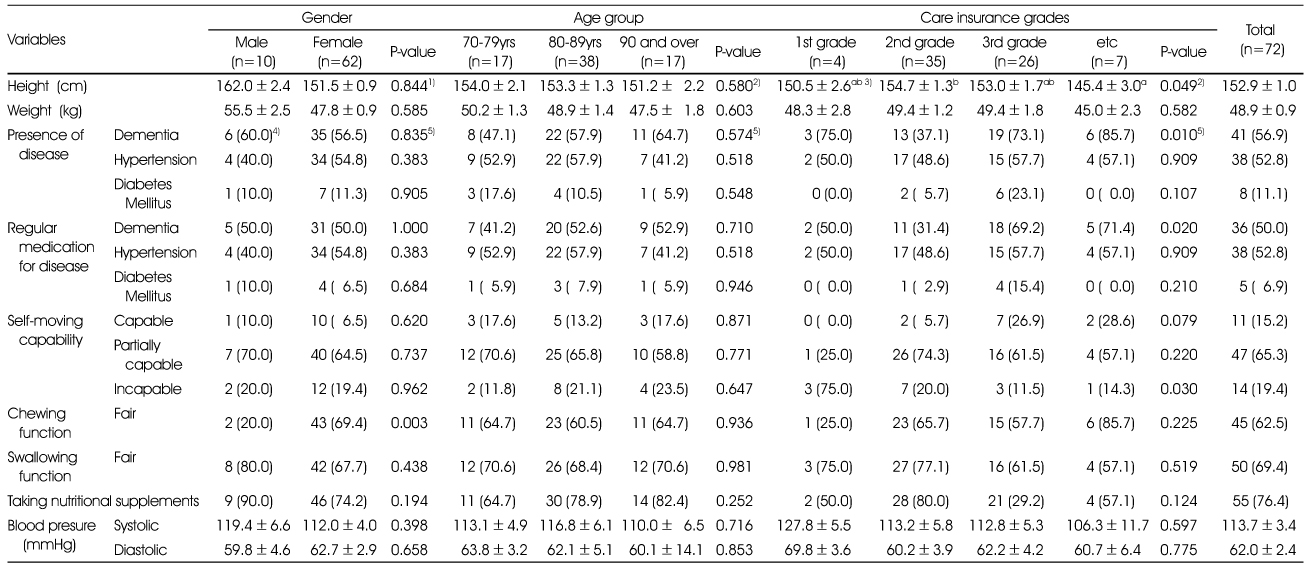

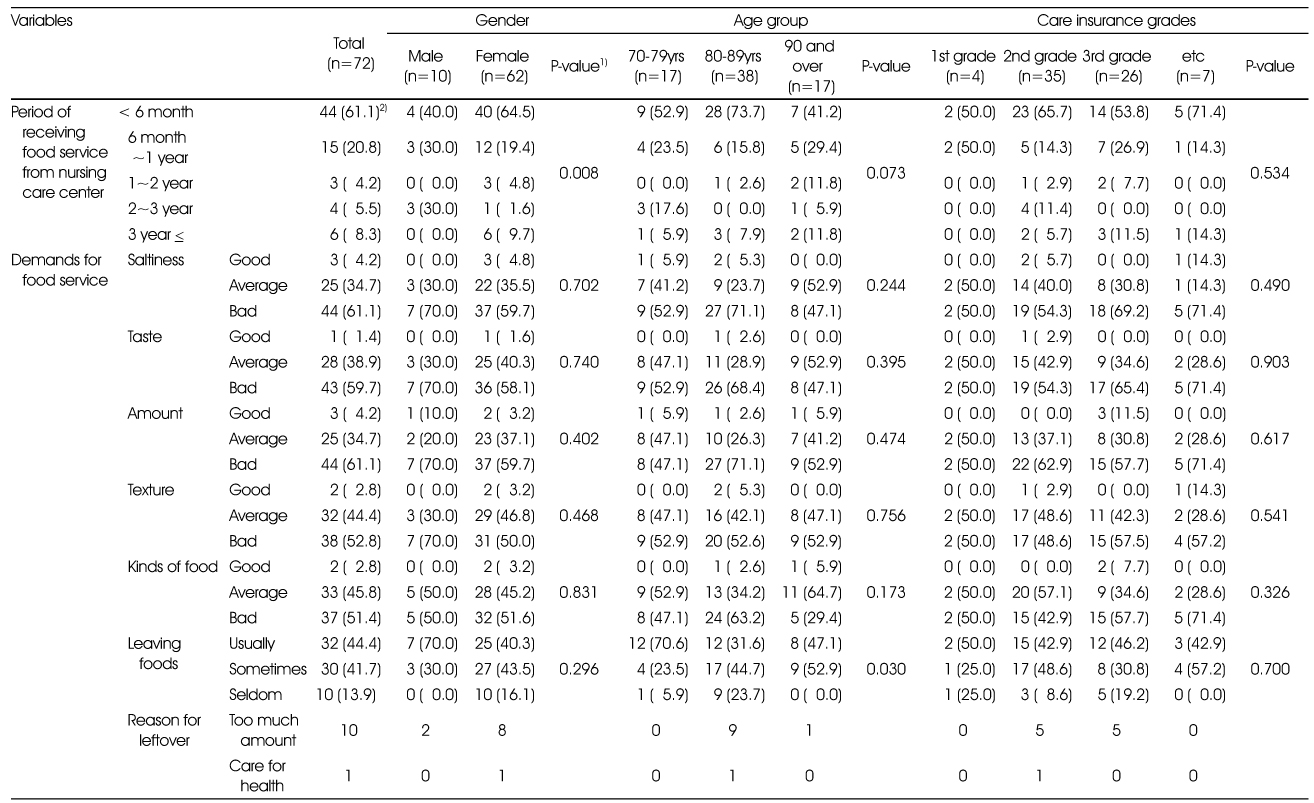

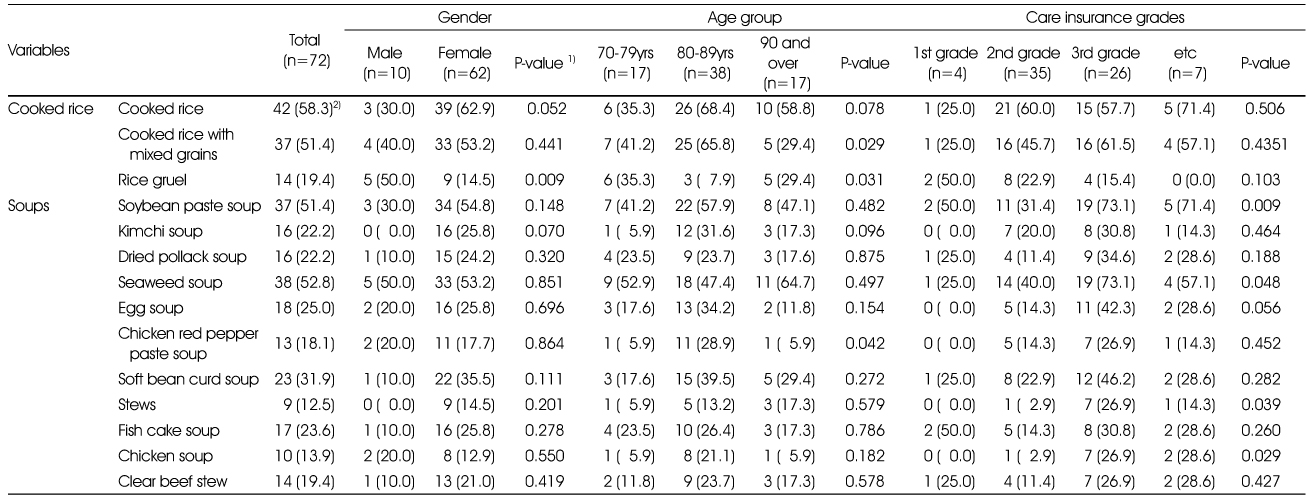
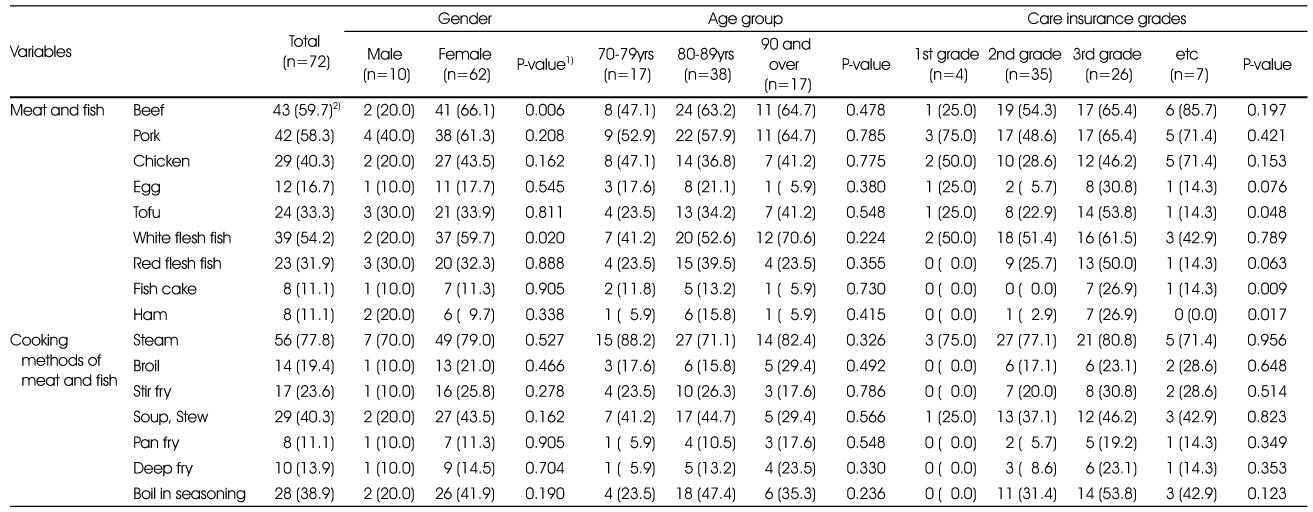
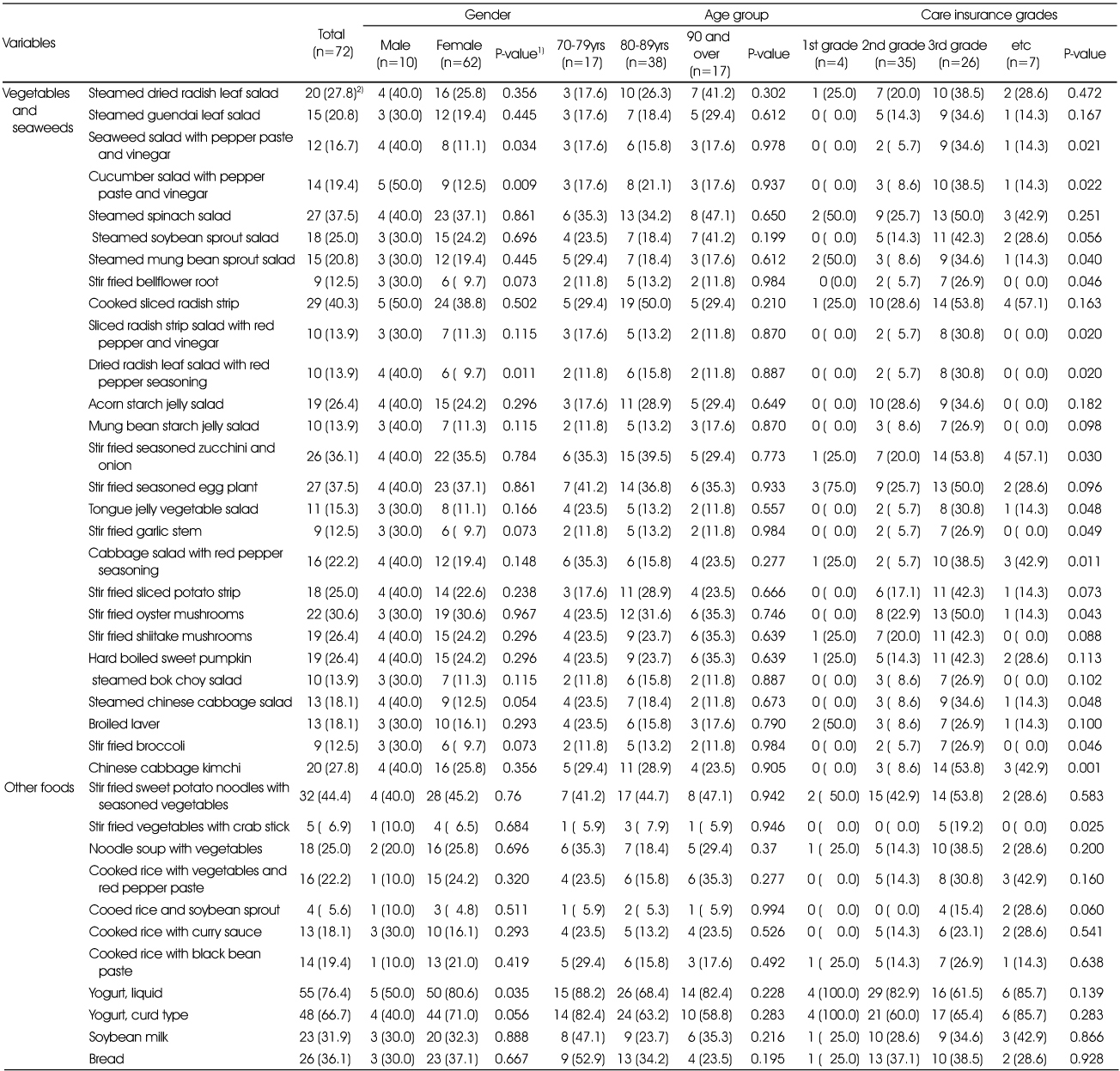

 PubReader
PubReader Cite
Cite


